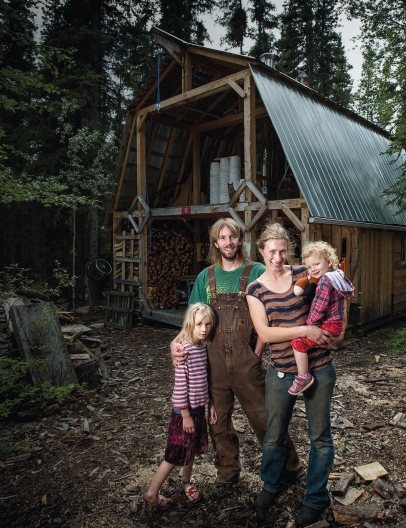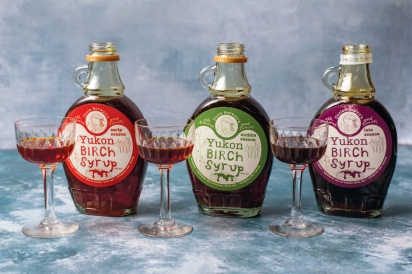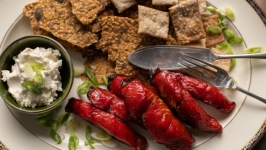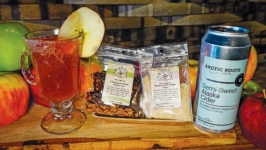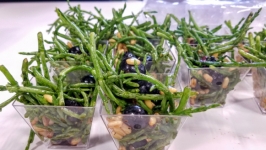Running into summer
The first sounds of spring are those of movement: water dripping from icicles, ice cracking and groaning as the current shifts it around, runners’ feet tapping pavement as their pumping legs relearn half-forgotten rhythms. The salmon are running too, still in the ocean in early spring, but swimming closer to shore, smelling their way to their home rivers and from there, their home streams. On land, in trees and shrubs, sap is running from root to opening bud, releasing spring scents of vanilla, resin, and lemon.
The sap is running in a birch stand on the McQuesten River too, 133 km south of Dawson City, where Berwyn Larson and Sylvia Frisch, with a team of volunteers, tap the trees for the sap that every year becomes Yukon Birch Syrup. Birch syrup fans are by now familiar with the astounding statistics, the staggering amount of physical labor associated with the operation. Fifteen hundred trees, connected by human effort to pipes and buckets, yield 120,000 liters (31,700 gallons) of sap, which heat and evaporation reduce to 750 liters (198 gallons) of syrup (the ratio is 110 gallons of sap to 1 gallon of syrup). Running the evaporator for the season gobbles up 15 cords of wood. That’s a lot of energy, human and otherwise.
In 2016, Larson and Frisch switched from blending syrup harvested throughout the season, which gives a uniform mid-range flavor, to separating it into early, mid, and late season. “In the early years we were still perfecting our craft,” says Frisch. “Late syrup is hard to finish. It caramelizes and burns easily.” The late syrup added flavor to the blended version, but she and Larson felt it couldn’t stand alone. Now it can. Experience has taught them techniques that lend the precision they need to ensure a great, late-season syrup—constant vigilance, controlling the wood fire, finishing the syrup on propane heat, and working in smaller batches.
The slow turning of spring into summer is mirrored in each stage of turning sap into syrups, though the syrup season typically lasts only a month or so. Early, mid, and late season syrups deliver different tastes, different viscosities. “Early season syrup tends to be sweet and clean and pure sugar tasting,” says Frisch. “There is no photosynthesis yet, the ground water is cold, so minerals don’t dissolve as readily, and the trees give the highest concentration of dissolved sugars.” This sugary, lightly-lemony syrup is best for dishes where you don’t need the full “punch” of birchy flavor—drizzled on pancakes, say, or baked into cranberry butter tarts (recipe follows). For those just getting to know birch syrup, early season is a good entry point.
As the season progresses, the sap, and therefore the syrup, alters. “The flavors build up, the colors deepen, the mineral deposits in the pans thicken, and the boil changes,” says Frisch. “At some point we taste a strong birch flavor and we switch to mid-season.” Mid-season syrup is marginally darker, it’s thicker, and the aftertaste delivers both umami and citrus to the tongue. This version is great for sweet and savory uses: in pecan pie, in salad dressings and marinades, or brushed onto salmon candy (recipe follows) as it smokes.
High drama begins in late season. “As soon as the smallest bit of green shows on the trees, photosynthesis starts and bitter notes enter the sap from the top down,” says Frisch. When an acid tang appears in the sap, the team switches to late season. The sap looks very different from early season. “Sometimes it turns a deep yellow. The boil is frothy with organic chemistry—think of the white froth we see on the high rushing rivers in the spring; dissolved organics make all that froth—the stuff of life!” Dissolved organic matter in water is indeed the stuff of life, a source of vitality carrying nutrients across landscapes just as spawning salmon carry nutrients from the ocean into the interior, feeding animals, earth, and trees.
In late season syrup, the stuff of life translates into a deep, dark, fully umami flavor, still sweet, still citrusy, but altogether more complex and earthy, marrying well with soy sauce, vinegar, ginger, and garlic, and an excellent finisher for sauces or braises that just need a little oomph.
Frisch says the running sap tells a story of renewal and connection, a narrative she can taste in the first sap of the season. “The very first sap can be a bit funny tasting. We think it is because the trees are flushing out their systems.” She speculates that the trees’ xylem, or vascular tissue, hasn’t been used since the previous year, and the fall photosynthates, or sugars, that last flushed through them have left a bitter residue.
For Frisch, that first bitter sap, which goes into the first batch of syrup, brings last season into this one; it’s part of the cycle, like salmon bringing other tastes and seasons with them, like spring runners tapping into muscle memory, like all of us bringing our whole selves in a headlong run into our sweet, short, northern summer.
First publish Edible Alaska Spring 2024.


